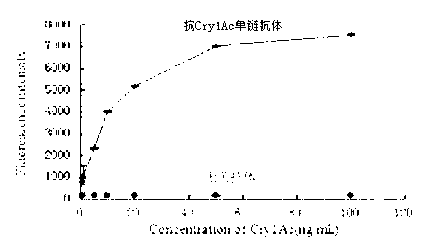Coding gene of anti-Cry1Ac toxin single-chain variable fragments (scFv) and immuno-polymerase chain reaction (PCR) detection method
A single-chain antibody, encoding gene technology, applied in the direction of anti-bacterial immunoglobulin, genetic engineering, plant genetic improvement, etc., to achieve the effect of reducing cost, high detection signal, and avoiding the process of reporting DNA markers
- Summary
- Abstract
- Description
- Claims
- Application Information
AI Technical Summary
Problems solved by technology
Method used
Image
Examples
Embodiment 1
[0033] Example 1. Screening of anti-Cry1Ac single chain antibody
[0034] In the affinity screening process of the present invention, the single-chain antibody gene contained in the human semi-synthetic antibody library (Tomlinson J) used is inserted into the phagemid pIT2, and the single-chain antibody is fused with the pIII protein when expressed in the phage On the capsid protein, it is a fusion type single chain antibody.
[0035] Coat the bottom of the cell culture flask with 4 mL of 100 μg / mL irrelevant protein at 4 °C overnight. The next day, after blocking with 2% MPBS, add the phage antibody library solution, incubate at room temperature for 2 h, transfer the supernatant to a cell culture flask coated with Cry1Ac and seal, incubate at room temperature for 2 h, and use 0.5% Tween-20 Wash away unbound or low-binding recombinant phages with PBS (10 washes in the first round, and 10 more washes in each subsequent round). For those with higher binding capacity, 200 μL ...
Embodiment 2
[0036] Example 2. Positive clone identification and sequence determination
[0037] Single colonies were randomly picked from the counting plates of the third and fourth rounds of screening and inoculated into 200 μL / well 96 microwell plates of 2×TY-AG medium, cultured at 250 rpm at 37 °C overnight, and the next day from Pipette 2 μL of bacterial solution from each well and transfer to a 96-well plate supplemented with 200 μL / well of 2×TY-AG medium, and incubate at 37 °C for 2 h at 250 rpm. After culturing the reseeded microwell plate for 2 h, add 25 μL of 2×TY-AG medium and add 10 9 pfu helper phage, continue to culture at 37 ℃ 250 rpm for 1 h, and finally at 1 800 g Centrifuge for 10 min and discard the supernatant. The bacterial pellet was resuspended in 200 μL 2×TY-AK medium, and cultured overnight at 30 °C and 250 rpm. The next day, at 1800 g After centrifugation for 10 min under the same conditions, the supernatant was taken for Phage-ELISA as follows:
[0038] ...
Embodiment 3
[0115] Example 3. Detection of Cry1Ac by immuno-PCR method
[0116] 1) Treat PCR tubes with 0.8% glutaraldehyde at 65 °C for 2 h and then air dry. Add 50 μL of the coating antigen Cry1Ac, dilute to 0.5-32 ng / mL with CBS and store overnight at 4 °C.
[0117] 2) Wash 3 times with PBST (0.05% Tween20), add 150 μL of blocking solution (3% MPBS, 0.1% SDS) and incubate at 37°C for 2 h.
[0118] 3) Wash with PBST (0.05% Tween20) 3 times. join 10 8 100 μL of pfu / mL phage antibody supernatant was incubated at 37 °C for 1 h.
[0119] 4) Wash 5 times with PBST (0.05% Tween20), and then wash 4 times with ultrapure water. Add primers and reaction system according to the following PCR steps, and perform PCR experiment. The primers are FAM-LMB3 and pHEN.
[0120]
[0121] Bacteria solution (template) 2 μL MgCl 2 (25mM) 2 μL 10× buffer 5 μL dNTP mix (10 mM) 1 μL FAM-LMB3 (100 μM) 0.1 μL pHEN (100 μM) 0.1 μL Taq (5 U / μL) ...
PUM
 Login to View More
Login to View More Abstract
Description
Claims
Application Information
 Login to View More
Login to View More - R&D
- Intellectual Property
- Life Sciences
- Materials
- Tech Scout
- Unparalleled Data Quality
- Higher Quality Content
- 60% Fewer Hallucinations
Browse by: Latest US Patents, China's latest patents, Technical Efficacy Thesaurus, Application Domain, Technology Topic, Popular Technical Reports.
© 2025 PatSnap. All rights reserved.Legal|Privacy policy|Modern Slavery Act Transparency Statement|Sitemap|About US| Contact US: help@patsnap.com


